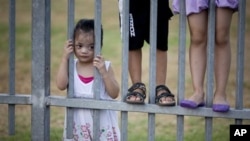Children are affected by migration on multiple levels. Some accompany a parent in looking for a more prosperous or safer life. Others may be left behind by migrating parents. Children sometimes migrate alone.
In all cases, the countries in which young migrants arrive are faced with problems. “That has both economic and social, as well as political dimensions,” according to Kathleen Newland of the Migration Policy Institute.
While the exact number of migrant children is hard to determine, estimates range from tens to hundereds of millions worldwide.
Besides their need for basic care and nurture, immigrant children pose unique challenges for receiving countries, which have to decide how and to what extent migrant youngsters should be integrated into their societies. Most nations have a policy for dealing with these issues.
“I think some are more intentional about it than others,” Newland said, “I think in many countries there is an assumption that entry into the public school system will do the job of integration.”
Newland said whether “integration” means eventual citizenship and societal acceptance differs from country to country.
“There are some countries that assume from the ‘get go’ [from the beginning] that child immigrants are here to stay,” she said.
But not all of them have the welcome mat out. She cited the Persian Gulf countries as examples of those that do not.
“You have a lot of countries that have labor-migration programs that don’t permit people to bring their families and that’s a very deliberate policy to avoid long-term settlement,” Newland explained.
Not all immigrant children come voluntarily. Some are forced to move because of war or natural disasters. Newland said agencies have to scramble to get services to children of forced migrants.
“In recent years there has been much more of an emphasis on education in emergencies by the international community,” she said.
For young children who find themselves in other countries without their parents there is the danger of human trafficking.
“They are extremely vulnerable—they’re vulnerable to trafficking—they’re vulnerable to exploitation—to injury,” Newland said.
Newland said a bright spot in the issue of immigrant children is that the plight of these children is becoming better known.
“The humanitarian agencies and NGOs--I think many of them are really ‘stepping up to the plate’ and are trying to focus particularly on the needs of children with things like education in emergencies, psycho-social services that are age-appropriate and that are reaching some of these kids,” she said.
In all cases, the countries in which young migrants arrive are faced with problems. “That has both economic and social, as well as political dimensions,” according to Kathleen Newland of the Migration Policy Institute.
While the exact number of migrant children is hard to determine, estimates range from tens to hundereds of millions worldwide.
Besides their need for basic care and nurture, immigrant children pose unique challenges for receiving countries, which have to decide how and to what extent migrant youngsters should be integrated into their societies. Most nations have a policy for dealing with these issues.
“I think some are more intentional about it than others,” Newland said, “I think in many countries there is an assumption that entry into the public school system will do the job of integration.”
Newland said whether “integration” means eventual citizenship and societal acceptance differs from country to country.
“There are some countries that assume from the ‘get go’ [from the beginning] that child immigrants are here to stay,” she said.
But not all of them have the welcome mat out. She cited the Persian Gulf countries as examples of those that do not.
“You have a lot of countries that have labor-migration programs that don’t permit people to bring their families and that’s a very deliberate policy to avoid long-term settlement,” Newland explained.
Not all immigrant children come voluntarily. Some are forced to move because of war or natural disasters. Newland said agencies have to scramble to get services to children of forced migrants.
“In recent years there has been much more of an emphasis on education in emergencies by the international community,” she said.
For young children who find themselves in other countries without their parents there is the danger of human trafficking.
“They are extremely vulnerable—they’re vulnerable to trafficking—they’re vulnerable to exploitation—to injury,” Newland said.
Newland said a bright spot in the issue of immigrant children is that the plight of these children is becoming better known.
“The humanitarian agencies and NGOs--I think many of them are really ‘stepping up to the plate’ and are trying to focus particularly on the needs of children with things like education in emergencies, psycho-social services that are age-appropriate and that are reaching some of these kids,” she said.










